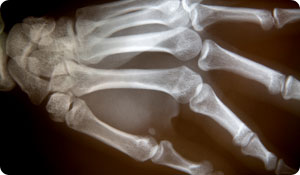
If you've been suffering from arthritis in your basal joint, the joint located at the base of the thumb, your doctor may have recommended surgery. But what exactly is involved in basal-joint surgery? And is it something you should consider?
Normally very mobile, the basal joint allows you to move your thumb into all kinds of positions that allow you to pick things up, button clothing, open lids and the like. When the joint degenerates, you typically experience pain that may be enough to prevent you from doing ordinary household tasks that you take for granted. For relief, your physician may suggest such therapies as anti-inflammatory medications, ice, heat, cortisone injections, thumb exercises, and even nutritional supplements.
But what if you can't get relief with any of those treatments? It may be time to think about basal-joint surgery. Depending on how advanced your condition is, your doctor may recommend one type of surgery over another. Initially, your doctor might want to insert a small instrument called an arthroscope into your basal joint. This instrument has a light and camera so the doctor can see the interior of the joint and determine what might need repairing and how it should be done. If the doctor decides that treatment is necessary, he or she may recommend one of these types of surgeries:
- Osteotomy. If the damage to your joint isn't too bad, the surgeon can straighten or reposition your bones to avoid further deformity. Your thumb should be nearly normal afterwards; however, this is only an option if the damage is in its early stages.
- Arthrodesis. Also known as joint fusion, this surgery fuses the bones in the joint. This gives the joint strength but not motion, although it should reduce pain. People whose work requires hand strength, such as manual laborers, may be particularly interested in this type of surgery.
- Trapeziectomy. The most common type of basal joint surgery, this involves removing the trapezium bone in the basal joint and replacing it with soft tendon tissue. The joint is held in place with a pin for several weeks so the tissue can heal. According to doctors, this surgery not only relieves pain, it completely removes the arthritis. Patients typically need physical therapy afterward to recover their strength.
- Arthroplasty. This procedure entails replacing part or all of the deteriorated joint with a graft from a soft tendon. Newer joint replacements include plastic or metal pieces, although soft tissue from the tendon is still preferred.
The good news about basal joint surgery? It can be performed on an outpatient basis and, with casts, splints and physical therapy, patients should recover fully within months.
Sources: Mayo Clinic, www.mayoclinic.com;
Cedar Valley Hand Surgery, Cedar Rapids, Iowa, www.cedarhand.com.





